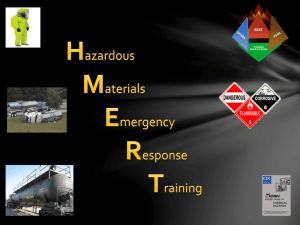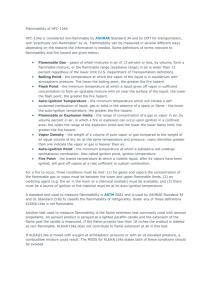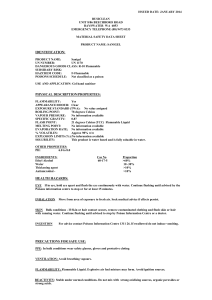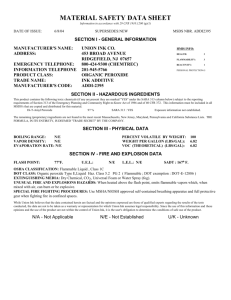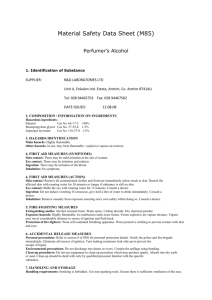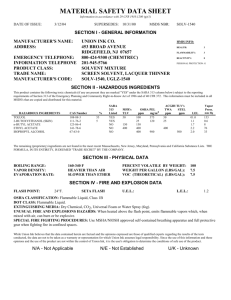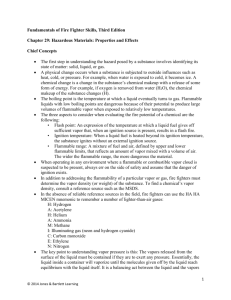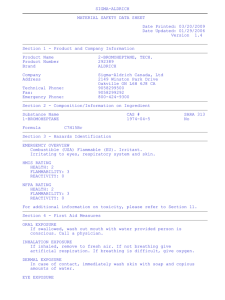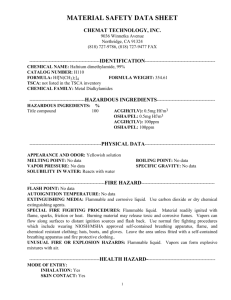Fires and Explosions
advertisement
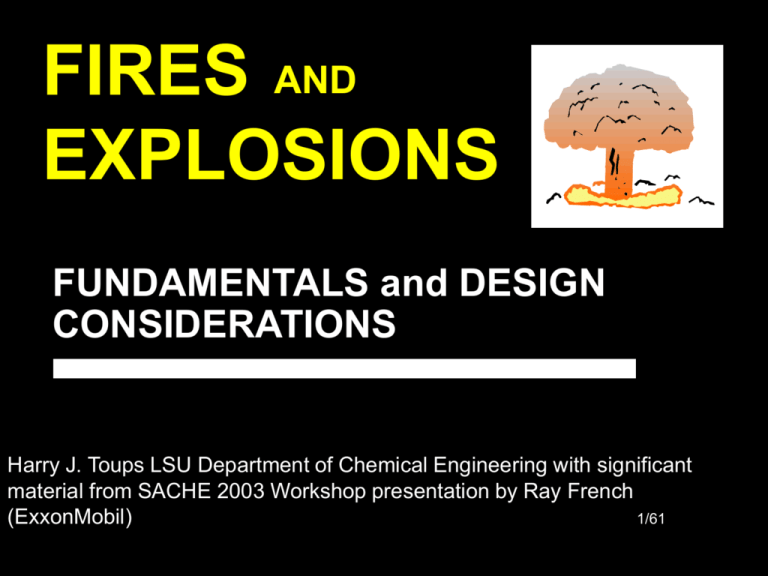
FIRES AND EXPLOSIONS FUNDAMENTALS and DESIGN CONSIDERATIONS Harry J. Toups LSU Department of Chemical Engineering with significant material from SACHE 2003 Workshop presentation by Ray French (ExxonMobil) 1/61 The Fire Triangle Oxidizers – Liquids – Liquids – Gases gasoline, acetone, ether, pentane – Solids Oxygen, fluorine, chlorine hydrogen peroxide, nitric acid, perchloric acid plastics, wood dust, fibers, metal particles – Gases – Solids Fuels: Metal peroxides, ammonium Ignition nitrate sources Sparks, flames, static electricity, heat acetylene, propane, carbon monoxide, hydrogen 2/61 Liquid Fuels – Definitions Flash Point – Lowest temperature at which a flammable liquid gives off enough vapor to form an ignitable mixture with air Flammable Liquids (NFPA) – Liquids with a flash point < 100°F Combustible Liquids (NFPA) – Liquids with a flash point 100°F 3/61 Vapor Mixtures – Definitions Flammable / Explosive Limits – Range of composition of material in air which will burn UFL – Upper Flammable Limit LFL – Lower Flammable Limit HEL – Higher Explosive Limit LEL – Lower Explosive Limit SAME SAME Measuring These Limits for Vapor-Air Mixtures – Known concentrations are placed in a closed vessel apparatus and then ignition is attempted 4/61 CONCENTRATION OF FUEL Flammability Relationships AUTO IGNITION MIST FLASH POINT FLAMMABLE REGION REGION FLAMMABLE TEMPERATURE AIT 5/61 Flash Point From Vapor Pressure Most materials start to burn at 50% stoichiometric For heptane: – C7H16 + 11 O2 = 7 CO2 + 8 H2O – Air = 11/ 0.21 = 52.38 moles air /mole of C7H16 at stoichiometric conditions – At 50% stoichiometric, C7H16 vol. % @ 0.9% – Experimental is 1.1% – For 1 vol. %, vapor pressure is 1 kPa temperature = 23o F – Experimental flash point temperature = 25o F 6/61 Flammability Diagram LOC 1 Atmosphere 25°C FLAMMABLE MIXTURES Limiting O2 Concentration: Vol. % O2 below which combustion can’t occur HEL LEL 7/61 Flammability Diagram LOC 1 Atmosphere 25°C Limiting O2 Concentration: Vol. % O2 below which combustion can’t occur HEL FLAMMABLE MIXTURES LEL 8/61 Flammable Limits Change With: Inerts Temperature Pressure 9/61 Effect of Temperature on Lower Limits of Flammability L E L, % 10/61 Natural Gas, volume% Effect of Pressure of Flammability HEL Natural Gas In Air at 28oC LEL Initial Pressure, Atm. 11/61 Minimum Ignition Energy Lowest amount of energy required for ignition – Major variable – Dependent on: Temperature % of combustible in combustant Type of compound 12/61 Minimum Ignition Energy Effects of Stoichiometry 13/61 Autoignition Temperature Temperature at which the vapor ignites spontaneously from the energy of the environment Function of: – Concentration of the vapor – Material in contact – Size of the containment 14/61 CONCENTRATION OF FUEL Flammability Relationships AUTO IGNITION MIST FLASH POINT FLAMMABLE REGION REGION FLAMMABLE TEMPERATURE AIT AIT 15/61 Autoignition Temperature Material Pentane in air Benzene Carbon disulfide Variation Autoignition Temperature 1.50% 3.75% 7.65% Iron flask Quartz flask 1018 °F 936 °F 889 °F 1252 °F 1060 °F 200 ml flask 1000 ml flask 10000 ml flask 248 °F 230 °F 205 °F 16/61 Autoignition Temperature 17/61 Auto-Oxidation The process of slow oxidation with accompanying evolution of heat, sometimes leading to autoignition if the energy is not removed from the system Liquids with relatively low volatility are particularly susceptible to this problem Liquids with high volatility are less susceptible to autoignition because they self-cool as a result of evaporation Known as spontaneous combustion when a fire results; e.g., oily rags in warm rooms; land fill fires 18/61 Adiabatic Compression Fuel and air will ignite if the vapors are compressed to an adiabatic temperature that exceeds the autoignition temperature Adiabatic Compression Ignition (ACI) Diesel engines operate on this principle; pre-ignition knocking in gasoline engines E.g., flammable vapors sucked into compressors; aluminum portable oxygen system fires 19/61 Ignition Sources of Major Fires Source Percent of Accidents Electrical 23 Smoking 18 Friction 10 Overheated Materials 8 Hot Surfaces 7 Burner Flames 7 … Cutting, Welding, Mech. Sparks 6 … Static Sparks 1 All Other 20 20/61 More Definitions Fire – A slow form of deflagration Deflagration – Propagating reactions in which the energy transfer from the reaction zone to the unreacted zone is accomplished thru ordinary transport processes such as heat and mass transfer. Detonation / Explosion – Propagating reactions in which energy is transferred from the reaction zone to the unreacted zone on a reactive shock wave. The velocity of the shock wave always exceeds sonic velocity in the reactant. 21/61 Classification of Explosions Rapid Equilibration of High Pressure Gas via Shock Wave EXPLOSION = Physical Explosions Uniform Reactions Thermal Explosions Chemical Explosions Propagating Reactions Detonations (Shock Wave) Deflagrations (Normal Transport) 22/61 Potential Energy Stored Volumes of Ideal Gas at 20° C PRESSURE, psig 10 100 1000 10000 TNT EQUIV., lbs. per ft3 0.001 0.02 1.42 6.53 TNT equivalent = 5 x 105 calories/lbm 23/61 Deflagration Combustion with flame speeds at nonturbulent velocities of 0.5 - 1 m/sec. Pressures rise by heat balance in fixed volume with pressure ratio of about 10. CH4 + 2 O2 Initial Mols Final Mols Initial Temp Final Temp Pressure Ratio Initial Pressure Final Pressure = = = = = = = = CO2 + 2 H2O + 21000 BTU/lb 1 + 2/.21 = 10.52 1 + 2 + 2(0.79/0.21) = 10.52 298oK 2500oK 9.7 1 bar (abs) 9.7 bar (abs) 24/61 Detonation Highly turbulent combustion Very high flame speeds Extremely high pressures >>10 bars 25/61 Pressure vs Time Characteristics OVERPRESSURE DETONATION VAPOR CLOUD DEFLAGRATION TIME 26/61 CONSEQUENCES 27/61 Bayway, NJ H-Oil Incident 1970 28/61 29/61 30/61 31/61 Two Special Cases Vapor Cloud Explosion Boiling Liquid /Expanding Vapor Explosion 32/61 U V C E N C O N F I N E D A P O R L O U D X P L O S I O N S An overpressure caused when a gas cloud detonates or deflagrates in open air rather than simply burns. 33/61 What Happens to a Vapor Cloud? Cloud will spread from too rich, through flammable range to too lean. Edges start to burn through deflagration (steady state combustion). Cloud will disperse through natural convection. Flame velocity will increase with containment and turbulence. If velocity is high enough cloud will detonate. If cloud is small enough with little confinement it cannot explode. 34/61 What Favors Hi Overpressures? Confinement – Prevents escape, increases turbulence – Higher probability of finding ignition source; more likely to generate overpressure Cloud composition – Unsaturated molecules – ‘all ethylene clouds explode’; low ignition energies; high flame speeds Large Vapor Clouds Source – Flashing liquids; high pressures; large, low or downward facing leaks Good weather – Stable atmospheres, low wind speeds 35/61 Impact of VCEs on People Peak Equivalent Overpressure Wind Velocity psi mph 1 70 2 160 5 290 10 15 470 20 670 30 35 940 50 65 Effects Knock personnel down Rupture eardrums Damage lungs Threshold fatalities 50% fatalities 99% fatalities 36/61 Impact of VCEs on Facilities Peak Overpressure psi 0.5-to-1 1-to-2 2-to-3 3-to-4 5 7 7-8 Typical Damage Glass windows break Common siding types fail: - corrugated asbestos shatters - corrugated steel panel joints fail - wood siding blows in Unreinforced concrete, cinder block walls fail Self-framed steel panel buildings collapse Oil storage tanks rupture Utility poles snap Loaded rail cars overturn Unreinforced brick walls fail 37/61 Vapor Clouds and TNT World of explosives is dominated by TNT impact which is understood. Vapor clouds, by analysis of incidents, seem to respond like TNT if we can determine the equivalent TNT. 1 pound of TNT has a LHV of 1890 BTU/lb. 1 pound of hydrocarbon has a LHV of about 19000 BTU/lb. A vapor cloud with a 10% efficiency will respond like a similar weight of TNT. 38/61 Multi-Energy Models Experts plotted efficiency against vapor cloud size and … reached no effective conclusions. Efficiencies were between 0.1% and 50% Recent developments in science suggest too many unknowns for simple TNT model. Key variables to overpressure effect are: – Quantity of combustant in explosion – Congestion/confinement for escape of combustion products – Number of serial explosions Multi-energy model is consistent with models and pilot explosions. 39/61 B L E V E O I L I N G I Q U I D X P A N D I N G A P O R X P L O S I O N S The result of a vessel failure in a fire and release of a pressurized liquid rapidly into the fire A pressure wave, a fire ball, vessel fragments and burning liquid droplets are usually the result 40/61 BLEVE FUEL SOURCE 41/61 BLEVE Video Clip 42/61 Distance Comparison INVENTORY (tons) 1 2 5 10 20 50 100 200 500 1000 UVCE BLEVE FIRE 120 150 200 250 310 420 530 670 900 1150 18 36 60 90 130 200 280 400 600 820 Distance in Meters 20 30 36 50 60 100 130 43/61 DESIGN for PREVENTION 44/61 Eliminate Ignition Sources Fire or Flames Typical Control – Furnaces and Boilers – Spacing and Layout – Flares – Spacing and Layout – Welding – Work Procedures – Sparks from Tools – Work Procedures – Spread from Other Areas jkdj – Sewer Design, Diking, dkdjfdk dkdfjdkkd jkfdkd fkd Weed Control, fjkd fjdkkf djkfdkf jkdkf dkf Housekeeping – Matches and Lighters – Procedures 45/61 Eliminate Ignition Sources Hot Surfaces Typical Control – Hot Pipes and Equipment – Spacing – Automotive Equipment – Procedures Typical Control Electrical – Area Classification – Sparks from Switches – Grounding, Inerting, – Static Sparks jkfdkd fjkdjd Relaxation kdjfdkd – Geometry, Snuffing – Lightning – Procedures – Handheld Electrical Equipment 46/61 Inerting – Vacuum Purging Most common procedure for inerting reactors Steps 1. Draw a vacuum 2. Relieve the vacuum with an inert gas 3. Repeat Steps 1 and 2 until the desired oxidant level is reached Oxidant Concentration after j cycles: PL j y yo( ) j PH where PL is vacuum level PH is inert pressure 47/61 Inerting – Pressure Purging Most common procedure for inerting reactors Steps 1. Add inert gas under pressure 2. Vent down to atmospheric pressure 3. Repeat Steps 1 and 2 until the desired oxidant level is reached Oxidant Concentration after j cycles: nL j y yo(n ) j H where nL is atmospheric moles nH is pressure moles 48/61 Vacuum? Pressure? Which? Pressure purging is faster because pressure differentials are greater (+PP) Vacuum purging uses less inert gas than pressure purging (+VP) Combining the two gains benefits of both especially if the initial cycle is a vacuum cycle (+ VP&PP) 49/61 Other Methods of Inerting Sweep-Through Purging – ‘In one end, and out the other’ – For equipment not rated for pressure, vacuum – Requires large quantities of inert gas Siphon – – – – Purging Fill vessel with a compatible liquid Use Sweep-Through on small vapor space Add inert purge gas as vessel is drained Very efficient for large storage vessels 50/61 Using the Flammability Diagram 1 Atmos. 25°C FLAMMABLE MIXTURES 51/61 Static Electricity Sparks resulting from static charge buildup (involving at least one poor conductor) and sudden discharge Household Example: walking across a rug and grabbing a door knob Industrial Example: Pumping nonconductive liquid through a pipe then subsequent grounding of the container Dangerous energy near flammable vapors Static buildup by walking across carpet 0.1 mJ 20 mJ 52/61 Double-Layer Charging Streaming Current – The flow of electricity produced by transferring electrons from one surface to another by a flowing fluid or solid – The larger the pipe / the faster the flow, the larger the current Relaxation Time – The time for a charge to dissipate by leakage – The lower the conductivity / the higher the dielectric constant, the longer the time 53/61 Controlling Static Electricity Reduce rate of charge generation – Reduce flow rates Increase the rate of charge relaxation – Relaxation tanks after filters, enlarged section of pipe before entering tanks Use bonding and grounding to prevent discharge 54/61 Controlling Static Electricity GROUNDING BONDING 55/61 Static Electricity – Real Life 56/61 Explosion Proof Equipment All electrical devices are inherent ignition sources If flammable materials might be present at times in an area, it is designated XP (Explosion Proof Required) Explosion-proof housing (or intrinsically-safe equipment) is required 57/61 Area Classification National Electrical Code (NEC) defines area classifications as a function of the nature and degree of process hazards present Class I Flammable gases/vapors present Class II Combustible dusts present Class III Combustible dusts present but not likely in suspension Group A Acetylene Group B Hydrogen, ethylene Group C CO, H2S Group D Butane, ethane Division 1 Flammable concentrations normally present Division 2 Flammable materials are normally in closed systems 58/61 VENTILATION Open-Air Plants – Average wind velocities are often high enough to safely dilute volatile chemical leaks Plants Inside Buildings – Local ventilation Purge boxes ‘Elephant trunks’ – Dilution ventilation (1 ft3/min/ft2 of floor area) When many small points of possible leaks exist 59/61 Summary Though they can often be reduced in magnitude or even sometimes designed out, many of the hazards that can lead to fires/explosions are unavoidable Eliminating at least one side of the Fire Triangle represents the best chance for avoiding fires and explosions 60/61 END of PRESENTATION 61/61

